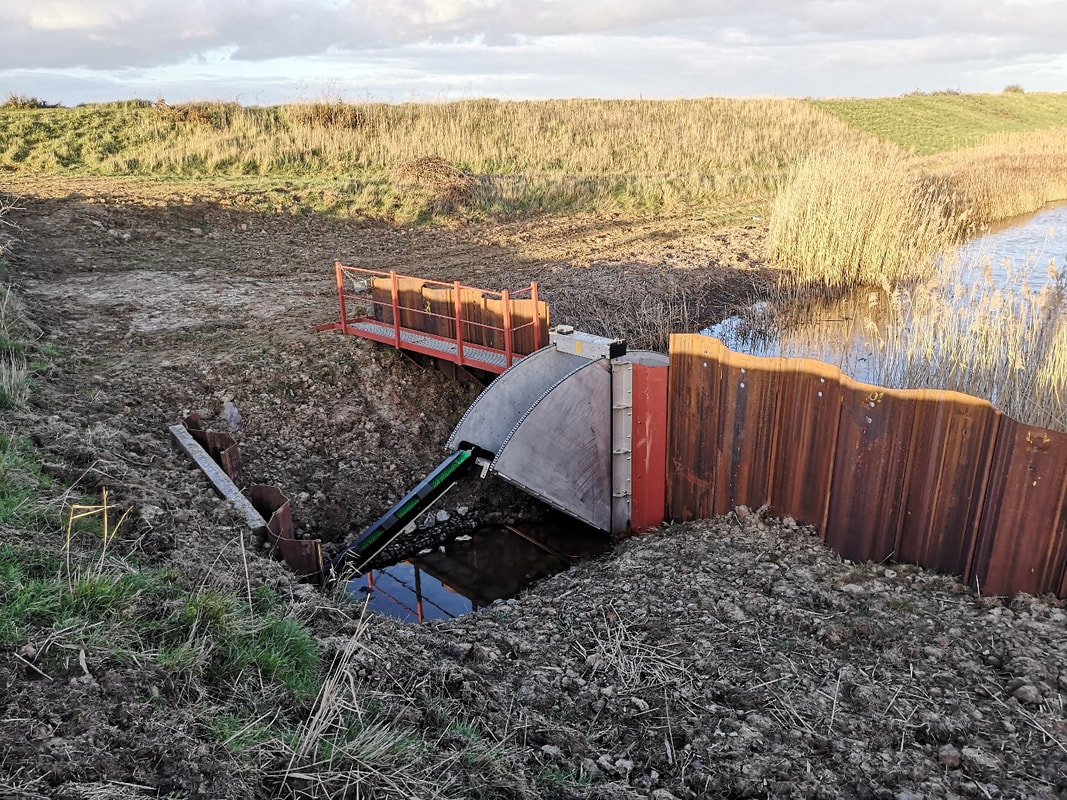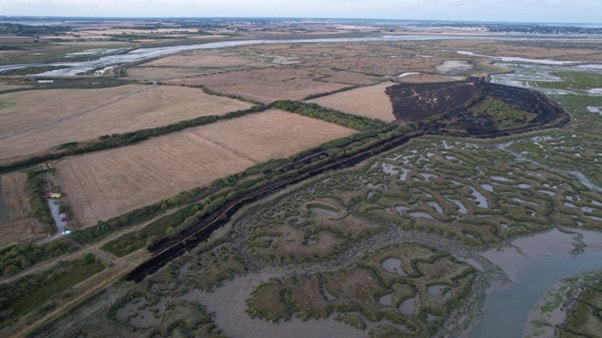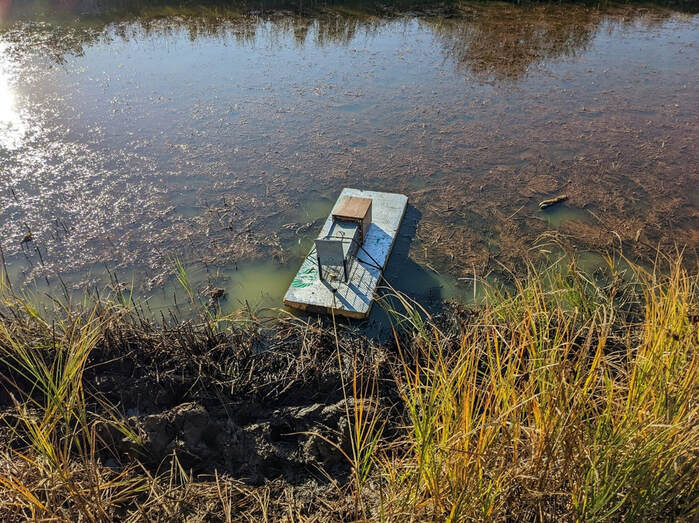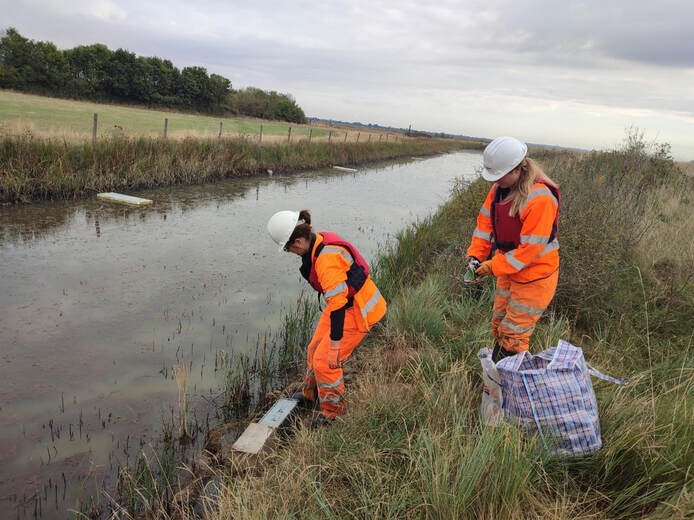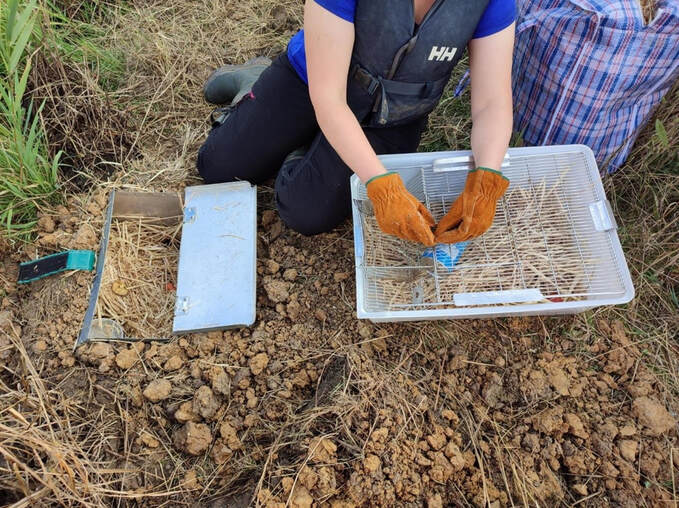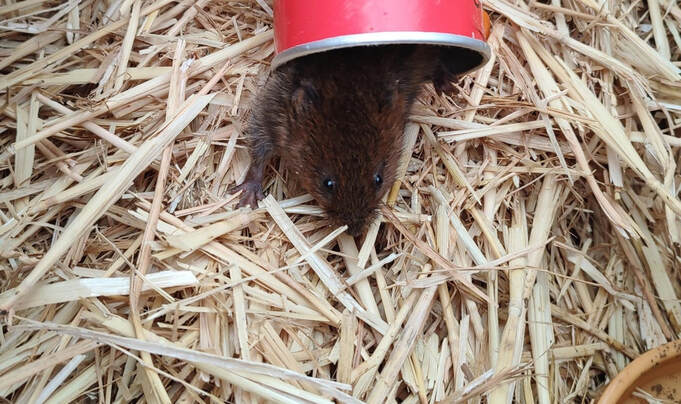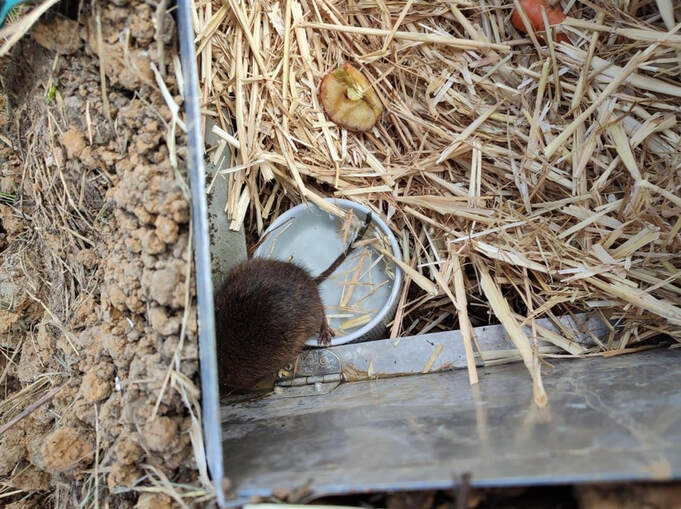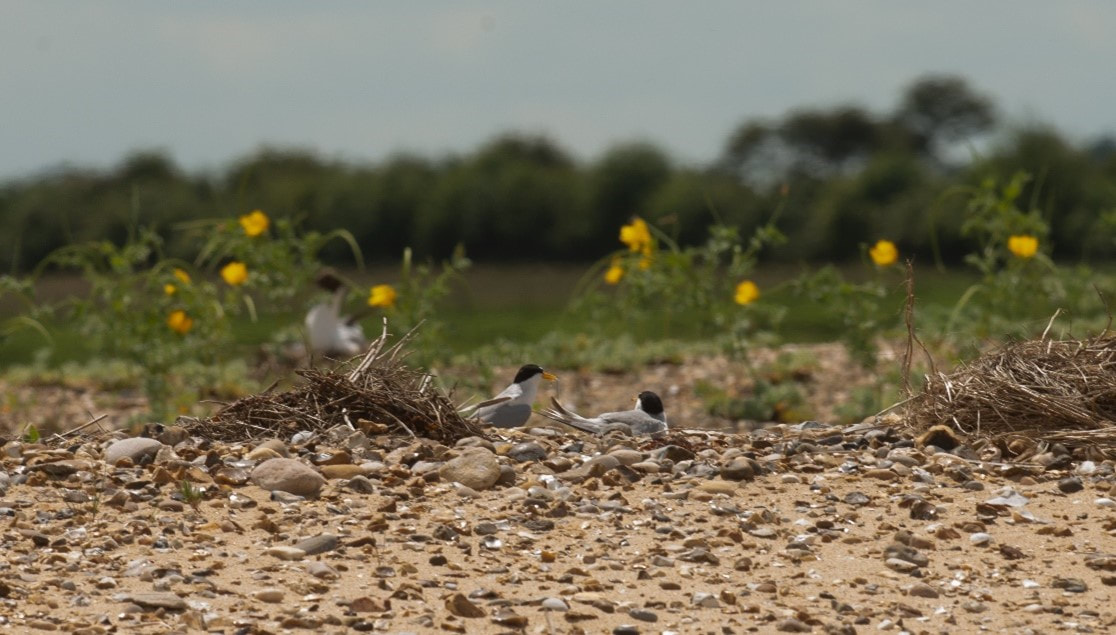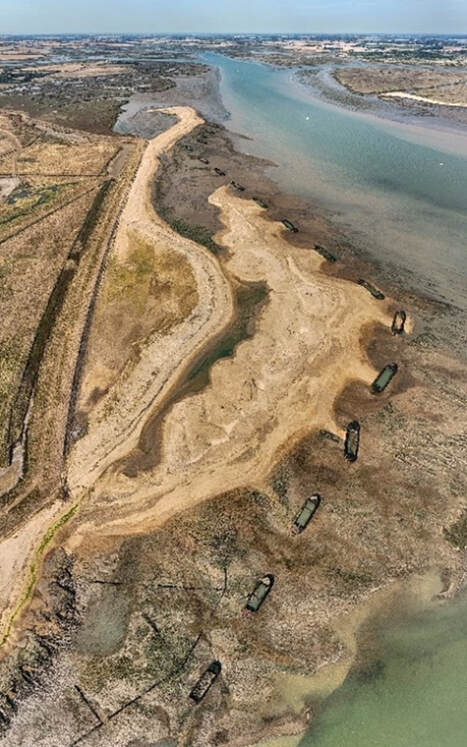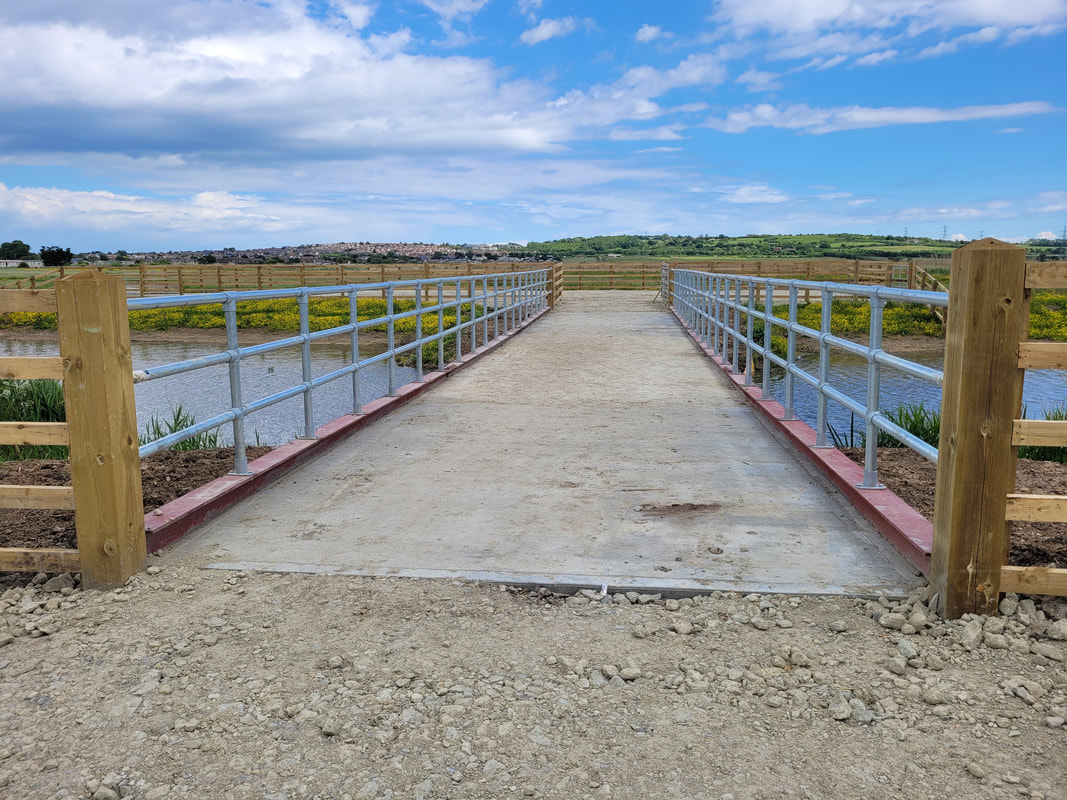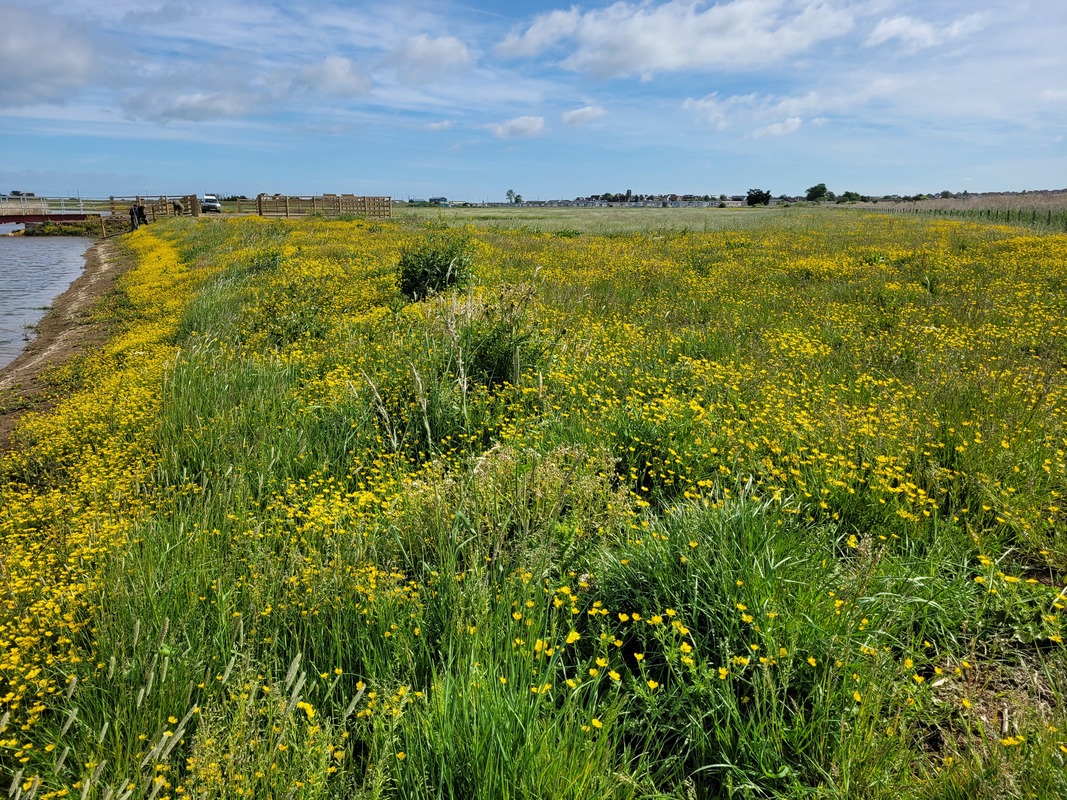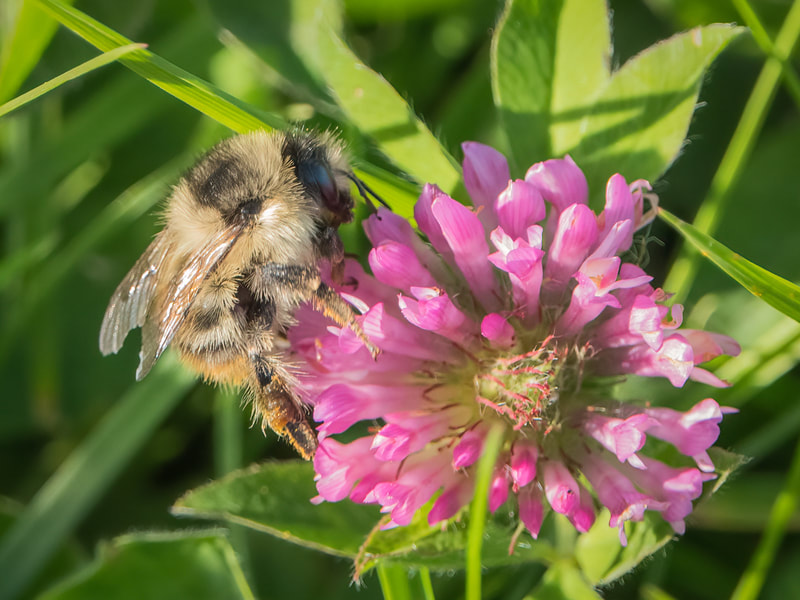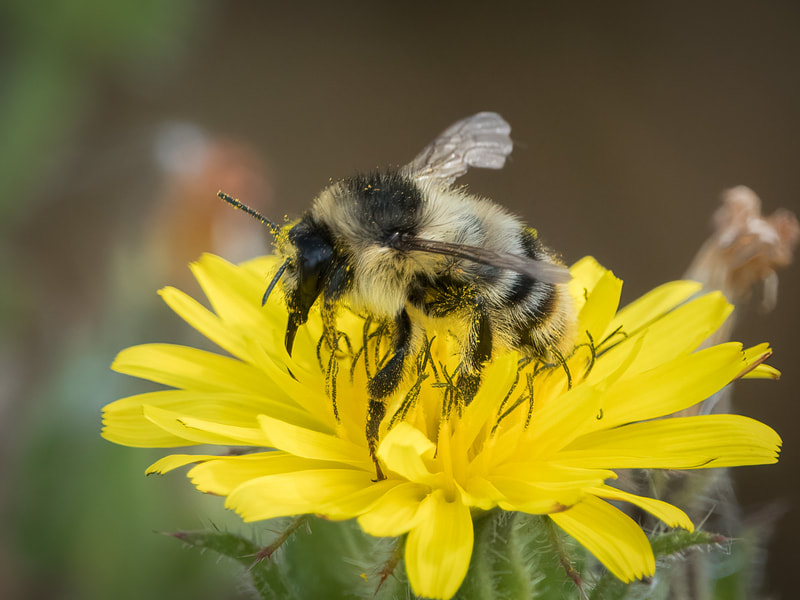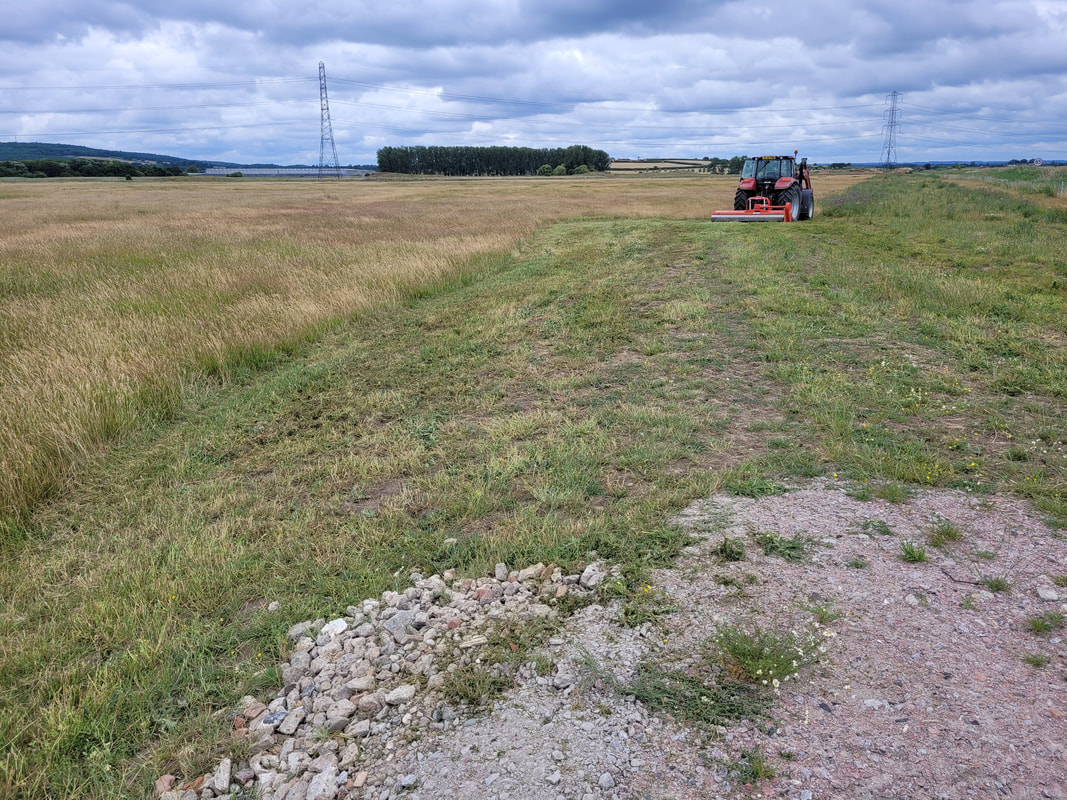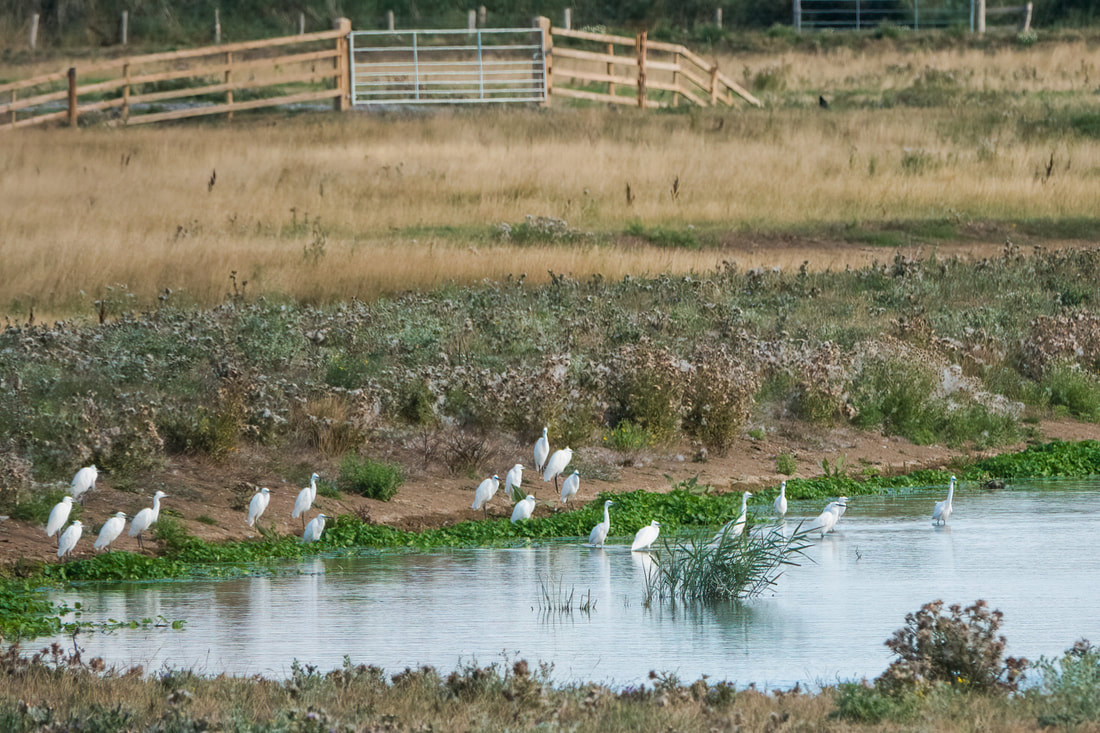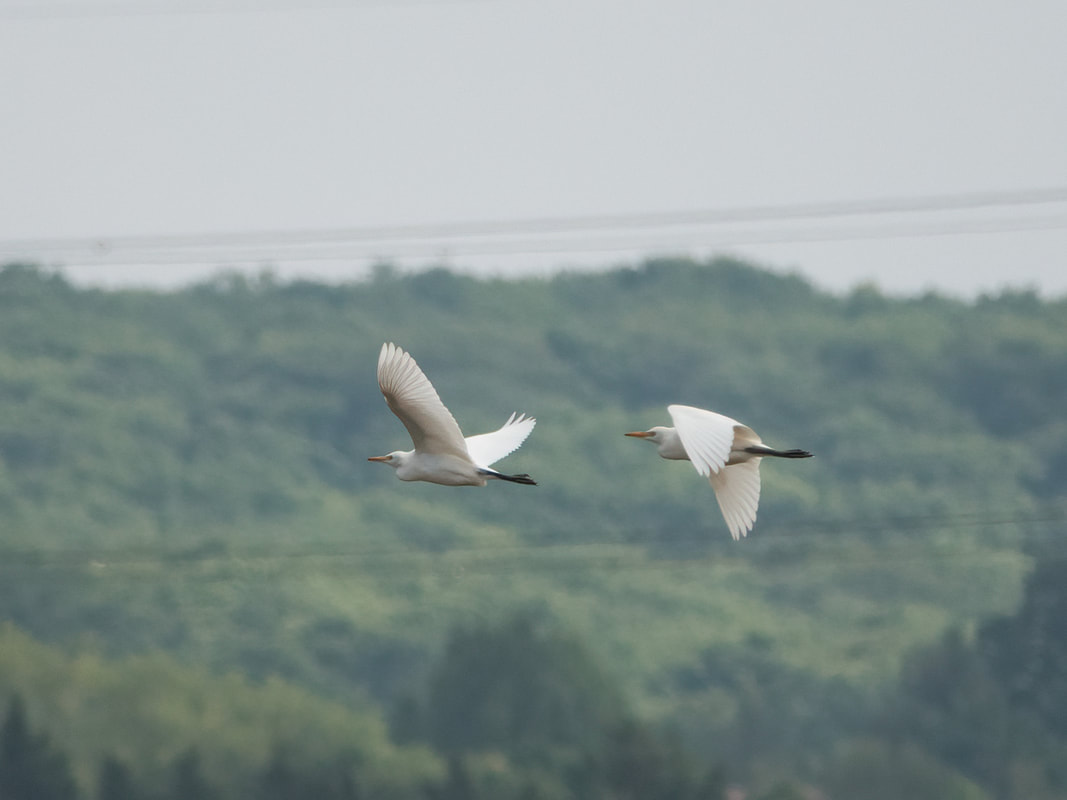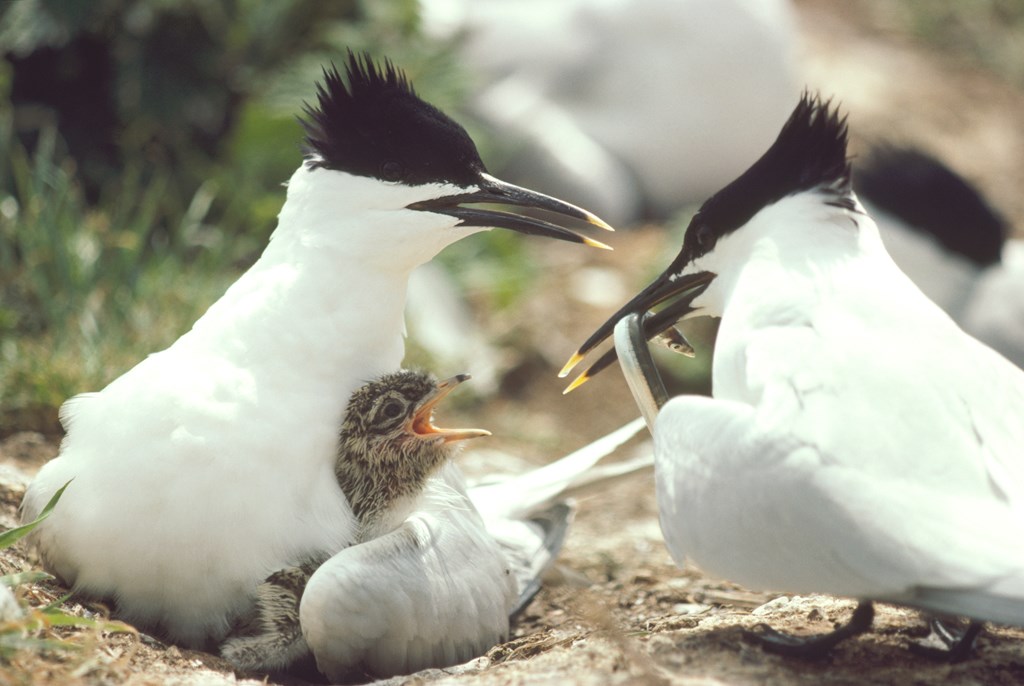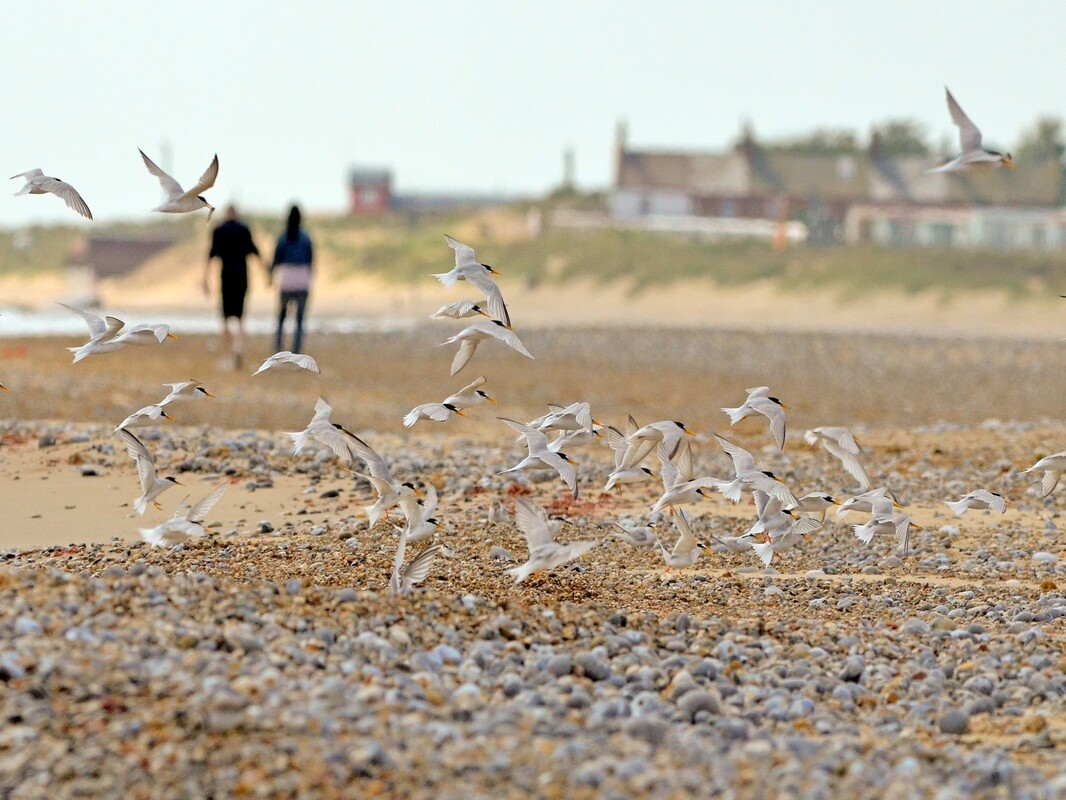|
Blog by Kieren Alexander - RSPB Site Manager, Old Hall Marshes Reserve Last Summer and Autumn was a time of high activity at Old Hall, as the next round of LIFE on the Edge works was completed. Like in previous years, the focus of the work was on reprofiling footdrains to benefit breeding waders by improving edge and then using this claimed material to rebuild and repair some historical but damaged crossing points. The latter for the purposes of allowing us finer and greater water control and greater compartmentalisation of the marshes. However, this time we also completed the installation of a new tilting weir with eel pass, this is an important update to the site’s infrastructure. It replaces an old, leaky and somewhat difficult to use wooden dropboard sluice with a new purpose built easier to use at all water levels sluice. The important part of this is the ability to use the sluice at all water levels, in the event of a saline incursion our ability to remove water from the marshes will be critical. This weir with its safe access route will enable us to do this. The other improvement reducing the amount of freshwater that was being lost through the old dropboard, freshwater is critical to the health of the marshes and is one of the things we can’t control. Although it may sound odd to have an eel pass on this, the borrowdyke where the weir is placed is hardly a main river, as eel numbers have dwindled freshwater marshes near the sea have become increasingly important as refuges for this species and is now home to a good number of eels. This eel pass will allow the eels that call Old Hall home to complete their natural lifecycle. It will ease passage into the marshes and then when the time comes allow them to leave the Marshes and return to the Sargasso sea to spawn, it what must be one of the most incredible migrations of any animal. During the works we were reminded of some of the pressures that are increasingly prevalent to highly valuable and designed sites, this time in the case of a wildfire which ripped through around 10ha of scrub on the marshes. Incidents like this remind us of why we need to start the careful adaptation of our protected sites and change the way we work. Later this year, we will be concluding our LIFE on the Edge work at Old Hall, with the installation of some new solar pumps but before that we have the breeding season to navigate, although we may not have received the water we would have wished for this winter (we seem to have been stuck in a dry high pressure system for months), the key fields are more or less where they need to be and before long lapwing will laying eggs and raising young across the marshes.
0 Comments
Blog by David Mason, National Trust Ranger After a busy summer and autumn, much of our coastal adaptation work on the island has paused for the winter and the site is closed to visitors. Brent geese and other waterfowl and waders now have the place largely to themselves. WeBS counts have recorded a wide range of birds on and around the island with avocet, curlew, golden and grey plover, redshank, dunlin, lapwing, black-tailed godwit, wigeon, teal and Brent geese being most numerous. Other species, mainly clustered around the new freshwater pond, have included yellow wagtail, linnet, whinchat and kingfisher. This has been a very useful source of freshwater for birds during the extended dry and hot weather this year, although levels dropped severely towards the end of the summer. This also led to new hedge plants suffering, which had to be watered several times to keep them alive. Blanket weed smothered newly planted marginal plants as the water levels dropped as well. Volunteers helped with the watering and clearing blanket weed. The abundant autumn rain has provided a welcome top up for the water features on site, however. Water vole translocation As I mentioned in my last blog the road to establishing new saltmarsh is a long and complicated one, and involves a number of stages and licenses which need to be complied with and completed before the next one can be implemented. One of these has now been completed. Following a successful process of habitat creation, trapping and translocation, 16 water voles have now been relocated to their new home out of the reach of the sea on Northey Island. As part of a Natural England licensed translocation of a protected species a new freshwater pond was created in 2021 and vegetation has since established to provide a new home for water voles (as well as being popular with local birds, as mentioned above). The vole’s less-than-optimal, existing habitat is threatened by inundation by the sea and is to be realigned as part of the LIFE saltmarsh creation project. The voles were trapped and translocated over several weeks by licensed professionals. The voles are carefully removed from the traps in cages, with tubes from a well known brand of crisp, their ideal hidey hole in transit. These are then used to place them into bottomless release boxes dug into the bank of the receptor pond. The voles can feed on provided carrots and apples and then burrow out when they are ready. The fence around the pond will keep them contained until they are fully established and the managed realignment works are completed. When removed, the voles will have access to a wider network of ponds and ditches around the island. Monitoring of the voles will continue to check on their progress over the coming years. The way is now clear to remove part of the embankment next year to allow the tide in and begin the next phase in process of establishing new saltmarsh. Visitor facilities A new path has been installed to the hide, which overlooks the new vole pond and what will be the new intertidal area following the embankment realignment. If they are lucky visitors may see a vole or hear a plop as they enter the water. Along the track we have also installed a viewing platform and bench overlooking the river and mudflats towards Maldon. I led a guided walk for visitors in September to talk about the threats to saltmarsh from climate change and sea level rise and the importance of the managed realignment and habitat creation project in contributing to saving this habitat. Attendees were able to use the new facilities for the first time. Remembering the history of Northey As well as providing important habitats for local wildlife, the island was also the site of Battle of Maldon between Anglo Saxon and Viking armies, which took place here in 991AD. This is commemorated in an epic Anglo Saxon poem and an exciting Lego renactment on YouTube. The latter captivated year 5 pupils at a local school to whom I recently gave a talk about the island as part of their studies of the Vikings. Nobel Peace Prize winner Sir Norman Angell also lived here in the 20th C. Links to previous blogs about Northey Island Part 1: www.projectlote.life/news/northey-island Part 2: www.projectlote.life/news/ntconservationadaption Blog by Kieren Alexander, Site Manager for RSPB Old Hall Marshes After the successful recharge operation of Autumn/Winter 2021, attention has now turned to monitoring both the breeding colony present on the island and of course how the sand and shingle is moving and responding to the water. Thankfully its good news on both fronts! Starting with the little tern colony and other beach nesting bird that nest at Horsey. Little terns had a great year, with 22 nests fledging 19 young. There were 14 AON’s on the new recharge and a further 8 on the old recharge, this is an increase of 5 nests and 11 fledged juveniles from 2021 and a welcome return to form for this colony that decreased during 2020 and the impact of recreational disturbance. Ringed plovers did well, with all four pairs of young fledging at least one chick each. Oystercatchers stayed stable at 10 pairs and there were the normal low levels of black headed gulls. We are thankful to the environmental team at Tendring District council, in particularly Leon Woodrow for erecting signage and closely monitoring the species and any potential disturbance over the summer months. What has been impressive is the way the little terns immediately colonised the new area of beach, with many nests found on this new area, this shows the importance not just of safeguarding existing colonies from the impacts of climate change (which was one of the aims of the project) but also the vital need to create new habitats for our species. As well as the beach nesting colony we have also been monitoring the sand and shingle and how it is moving in response to tide and wind after being recharged. We are lucky at Horsey in that we have real life model that was created in the 1990’s in the form of the existing beach (to the west in the photo). So, we have a strong idea of how the material will respond. However, it is always nice to see the theory become reality. The GIF below shows the results of our monitoring since the material was deposited, so far, we have undertaken three monitoring flights and it shows the material initially being smoothed out and then gradually being pushed landwards towards the existing beach and then following a classic longshore drift movement to the west, making it a near mirror image of the existing beach.
Movement has been slow so far, but it is assumed that the material does a lot of its moving in the winter season, so the next results of the next two flights will be interesting to see and how it continues to respond. In case you missed it, here is the link to first part of Horsey Island Recharge Project blog, the second part and the third part. By Audrey Jost - Assistant Warden at RSPB Seasalter Levels and Blean Woods May 2022 saw the completion of the habitat restoration works at Seasalter Levels. This massive project enabled the creation of 40 crossings/dams, 50 bunds/plugs, 20 islands and nearly 120,000 m2 of rills and scrapes, connected to waterways via culverts and elbow pipes. Over 2,000 m of ditches were restored and 3 trailer mounted water pumps were purchased to replace defective trash pumps, with solar pumps planned to be installed in 2023. 4,000 m of stock fencing and 3 new livestock corrals also were installed, allowing us to introduce large-scale grazing across the reserve. The addition of a bridge linking Alberta and Whitstable Bay Estate, in the north of the reserve further increased connectivity across the site. Spring brought colourful changes to the site as bunds and islands transformed from dark brown to bright yellow with the apparition of bulbous buttercups. This attracted lots of pollinators, with 365 bumblebees recorded by our volunteer surveyor in Alberta, our highest number since starting in 2018! The highlight of this survey was the record of 5 shrill carder bees, one of the UK’s rarest bumblebees. Several shrill carder bees were also spotted on the other side of the bridge in Whitstable Bay Estate, indicating that the species is slowly colonising the site. Unfortunately, we were unable to efficiently control water levels and flood fields this year due to the inability to obtain an abstraction licence. The licence acquisition is however planned for 2023, with a year’s worth of water levels, salinity and flow rates monitoring required by the Environment Agency. Despite all this, the breeding season at Seasalter Levels showed encouraging results, as a small part of the site retained rainwater naturally. Species that successfully bred on the reserve included lapwings, little grebes, pochards, shovelers and gadwalls! After breeding season was over, we carried out habitat management tasks, putting our new tractor into good use as we undertook topping across the site. Despite the site quickly drying out due to the drought and the impossibility of pumping, many different species visited the Levels throughout summer. They ranged from waders such as greenshank, redshank, green and common sandpipers to raptors such as hen harrier and hobby. Rarer birds such as purple heron and glossy ibis were also amongst the reserve’s visitors. We even had a surprise bittern in the reedbed! The remaining water pockets of the site are not to be outdone. The newly created shelf in the main ditch between Alberta and Whitstable Bay Estate is a good example where up to 30 little egrets are seen on a regular basis! If you’re lucky, you may even spot cattle egrets amongst them! 5 months after the official end of the habitat works, the restoration of Seasalter Levels is still a work in progress. Changes are definitely happening but it will take time for the reserve to become a fully functional wetland. Stay tuned for future updates!
Links to the previous blogs on the restoration of Seasalter Levels: Part One and Part Two Blog by Leigh Lock, RSPB Project Development Manager The global and national threats to seabirds are widely recognised and much focus understandably links the status of seabirds with the state of our seas which is where most seabirds spend most of their time. But what about the state of the ‘land’ where seabirds spend the breeding season – a critical phase of their lifecycle? As a land-based observer of birds on the coast for decades, the growing pressure on breeding seabird sites has been a major concern and I feel we have reached a tipping point where if we don’t act now there will be no safe nesting space left for seabirds in some areas in the future. Therefore, I was excited by the prospect of Seabird Conservation Strategies being developed within all four UK counties by government – each will set out the strategic needs of our seabird species and set out a route map for their recovery. This process in England has been led by DEFRA and NE. But I wanted to make sure that the current state of seabird colonies in England was reflected in this process and that the thoughts and concerns of those most close to the sites – the site managers, conservation officers etc responsible for these areas– were captured. So I contacted as many of those key people around the coast as possible to gather views on pressures impacting on seabird colonies. This is probably the first time such an assessment has been made. Much of this information gathered was necessarily subjective, being based on the opinions of the site managers, and others. However, expert judgement provided by the site managers most familiar with the sites, and their issues, constitutes the best available evidence on issues affecting England’s breeding seabirds. The process does present a ‘ground truthing’ to compare with other available data sources so that all the available information together can be used as ‘weight of evidence’ to identify the main issues and develop solutions to them. Working closely with colleagues within NE, we then looked to align this rather broad-brush assessment of pressures on colonies with other data sources being carried out to inform other areas of the strategy. Information was gathered on 222 natural sites (i.e., excluding urban gulls) and covering 24 seabird species – this representing the vast majority of England’s seabirds. Pressures were assigned to predefined categories including disturbance, habitat loss, predation, invasive species, disease, and control. Note that the assessments were carried out before the widespread and serious impacts of Avian Influenza (AI) were recorded in England in 2022. Overall, the most widespread was disturbance (see below), with both habitat loss and predation impacting on over 50% of the sites. The other pressures were recorded at far less sites, although their impacts at individual sites could be very significant (e.g., invasive species on islands). There are plenty of discussion points emerging from this but below I have pulled out just three. 1. The widespread impacts of disturbance Disturbance is the most widely reported pressure affecting England’s breeding seabirds impacting on 89% of the coastal sites, all sites supporting species like little tern and Sandwich tern, and 100% of English SPAs with breeding seabird features. Site managers see disturbance as THE rapidly growing issue, and human recreational disturbance at coastal sites is predicted to increase. Disturbance of nesting seabirds is caused by a range of recreational activities – beachgoers, dogwalkers and recreational fishers on land, and recreational watercraft such as jet skis, paddleboarders from the sea. Although disturbance is particularly an issue for ground-nesting birds such as terns and gulls at soft coast sites, I was also surprised how widely it was reported at cliff colonies and even offshore islands where birds vulnerable to disturbance from the sea. Disturbance at nest sites can have significant negative impacts on seabird breeding success through increased exposure of eggs and young to predation and the elements and can lead to the abandonment of nest sites and even entire colonies. What I see are overstretched, under resourced conservation organisations trying to manage coastal sites where nature conservation should be the priority, but recreational interests prevail. Many areas have wardens to ‘protect’ nesting birds and engage with the public. But without zonation policies and legislation to restrict certain activities, on-site teams of staff and volunteers face an uphill battle, and the birds using these sites face a bleak future. 2. Sea level rise and coastal erosion present an existential threat to some of England’s most important seabird colonies. Within England, most seabird sites occur on ‘soft coast’ sites – nearshore islands, salt marshes, lagoon islands and shingle banks. These habitats are under massive pressure and the reduction in size and quality of nesting habitat is the second most widespread pressure in England. Without intervention, 2,000 Ha of protected coastal habitats is predicted to be lost in England by 2060 with even greater areas being functionally lost as breeding habitat due to regular flooding. Previously, these losses were mainly from development and land claim, but the key future threats to coastal habitats are from climate change-related sea level rise, coastal erosion, and coastal squeeze. Mean sea levels in the UK have already risen by approximately 17 cm since the start of the 20th century and climate predictions show that they will continue to rise under all emissions scenarios until at least the year 2100. Increases in sea level rise are difficult to predict but are likely to be greatest in southern and eastern England where some of the largest colonies are. Rising sea levels mean that more coastal seabird breeding habitat will be lost, and the risk of intermittent flooding of nest sites is also increased. In addition to mean sea level rise, the risks of extreme sea levels and flooding are compounded by increases in storm events. Species that nest on the ground in sand and shingle habitats, such as terns and gulls, are particularly at risk, as large areas of these types of habitats can be lost rapidly with only minor increases in sea level. Many current breeding sites for terns and gulls on beaches and low-lying near-shore islands which are likely to become unsuitable or be lost entirely within the next 10 years. Little terns are particularly at risk because they tend to nest just above the high-water mark and in recent years high proportions of the UK’s little tern nests have been flooded out during spring tides and storm surges. Short term fixes are in place at many sites. Habitat management to keep sites open, recharge of shingle islands to raise their levels above highest tides but longer-term measures are required to ensure that seabirds have safe nesting sites for future decades not just the next few years. This involves factoring seabird breeding habitat into multi-stakeholder strategic management planning eg Shoreline Management Plans (SMPs), Nature Recovery Networks (NRNs), Local Nature Recovery Strategies (LNRS)) and the implementation of the government’s 25-year Environment Plan. Breeding seabirds should be considered in full as part of these overarching plans and programmes, to ensure that existing breeding sites are adequately managed, and new breeding habitat is created and maintained, and linked to funding streams like Biodiversity Net Gain. 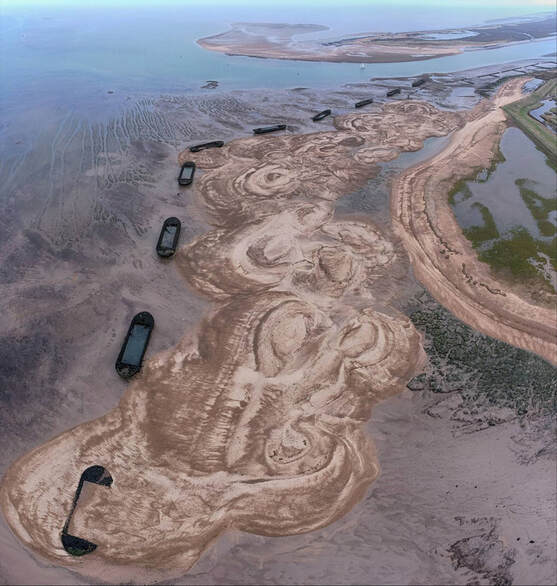 Beneficial use of dredged sediment can be used more widely to provide habitat for nesting seabirds and provide natural sea defences – here 50,000 cubic metres of sediment delivered through @ProjectLOTE working with Harwich Haven Authority, EA and the landowner supports the most important little tern colony in Essex (c) JPullen 3. Avian Influenza and the in-combination effects.
As mentioned above, the assessment was carried out last year before the impacts of AI were recorded in England this summer. Disease was not noted as a significant pressure and has not really impacted on seabirds since botulism on gulls in the past. But the impacts of AI in 2022 have been severe – impacting significantly on the largest UK and England colonies of both roseate and sandwich terns – Coquet and Scolt Head Islands respectively -with 1000s of dead breeding adults and large-scale breeding failure at these colonies. we await a full assessment of the impact of AI on seabirds in 2022 and how it might impact in the future. But think of the conditions under which AI was able to make such an impact. The ‘in combination’ effects of habitat loss, predation, disturbance have pushed seabirds to the edge – habitat loss squeezing seabirds into fewer and fewer suitable areas, which then become honey pots for predators, and even these few special sites coming under the unbearable pressure of disturbance. All our eggs in fewer and fewer baskets. And then a disease comes along which thrives in conditions where it can spread rapidly amongst individuals in closely packed colonies. To have seabird populations that can be resilient to AI and other diseases, we need more space for them to nest safely, allowing more colonies to thrive, and allowing more mobility from site to site to respond to changes in local conditions. Building resilience to disease and other pressures, requires spreading the risk – more and bigger sites, better managed. For this we need to rethink how our coast is managed. The report The full report is on the documents page of this website. Lock, L., Donato, B., Jones, R., Macleod-Nolan, C. 2022 England’s breeding seabirds: A review of the status of their breeding sites and suggested measures for their recovery. RSPB and Natural England report. The report highlights the most important sites and actions for the recovery of seabirds in England. The recommendations from this report on site management have been incorporated into a wider set of recommendations covering the full suite of seabird ecology -under four categories -breeding, feeding, surviving and knowledge. These recommendations have been made by NE to DEFRA to inform the further development of the England Seabird Conservation Strategy and the implementation of the 25 Year Plan. The Strategy should be available early in 2023. Through ProjectLOTE we will continue to advocate for these changes and work with stakeholders all-round the coast to deliver what we can to help seabirds. Final thoughts There are probably few more committed and enthusiastic workers than those managing seabird colonies and they are doing a brilliant job holding the line against growing pressures from all directions. But they need help. For all the above reasons, the England Seabird Conservation Strategy couldn’t come at a better time, and we must all hope that it brings a step change in the priority and resources allocated to management of seabird colonies in England. Over to you DEFRA. Thanks to all those who contributed information towards this assessment. Good luck to all of you with your challenges ahead. |
Archives
April 2024
Categories
All
Photo credits: Oystercatcher by Katie Nethercoat (rspb-images.com)
LOTE Logo credits: Saskia Wischnewski |

